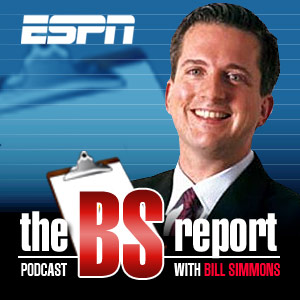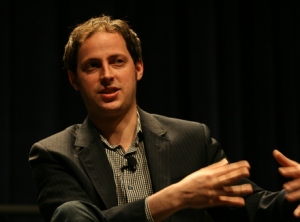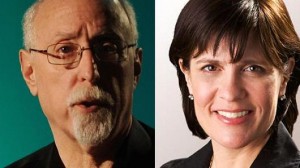What I’m calling the personal franchise model in journalism is not new. I.F. Stone’s Weekly was a personal franchise — it fit the definition I am about to give you — and he started that in 1953. Also, I’m not trying to be comprehensive in this analysis. There are instances of the personal franchise model that I am not going to mention.
There are lots of sites built around individuals, like almost every blog in the world. There are lots of born-on-the-web news companies, and they were all begun by individuals. By “personal franchise” I mean something more: a central figure or personality has given birth to a newsroom, a larger operation. But the larger operation still feels like an individual’s site.
The personal franchise model in digital journalism, simple definition:
A news and commentary site built around the talent and sensibility of an individual journalist with a unique voice and a following online.
Key features:
* Charismatic journalist — and founder — at the center, joined by a staff hand picked by the founder.
* Editorial control rests with the founder, even when ownership does not.
* Stands in contrast to the more institutional news brands — like BusinessWeek, The Washington Post, NPR, or Politico — where talented people come and go while reputation attaches to the name, product (and logo!) of the institution.
* Talking Points Memo doesn’t really exist without its founder, Josh Marshall, but the Washington Post definitely exists — and persists — without Marty Baron, its current editor.
* Identifiable niche or approach. No attempt to be comprehensive or to offer “all news to all people.”
* Mix of news, opinion, analysis, data without a lot of fuss about separating these categories. Plenty of voice, attitude and style mixed in.
* Business model (or subsidy system) varies from site to site. There is no one best way to do it.
Eleven examples of the personal franchise model in news:
1. Dealbook, Andrew Ross Sorkin, New York Times
2. Grantland, Bill Simmons, ESPN
3. Five thirty eight, Nate Silver, ESPN.
4. xoJane, Jane Pratt, Say Media
5. GigaOm, Om Malik, independent
6. Talking Points Memo, Josh Marshall, independent
7. Daily Dish, Andrew Sullivan, independent
8. Recode.net, Walt Mossberg and Kara Swisher, independent
9. Tech Dirt, Mike Masnick, independent
10. Project X, Ezra Klein, Vox Media
11. The Information, Jessica Lessin, independent
Other possibilities not included: Drudge Report, Huffington Post, MMQB.
1. Dealbook, Andrew Ross Sorkin
Beat: Deal making on Wall Street among the major players in finance.
Built around: The reporting skills, source network, “inside” approach and television presence of Andrew Ross Sorkin.
Founder is: A business reporter and columnist for the New York Times, book author, television pundit for CNBC.
Background: Mergers and acquisitions reporter for the Times.
Ownership: Wholly owned by the New York Times.
Business model: Email newsletter, advertising, sponsorship, conferences.
Beat: Sports and popular culture
Built around: The writing style, audience intimacy and editorial vision of Bill Simmons.
Founder is: Writer, columnist, podcaster, interviewer, occasional TV commentator and Boston sports guy.
Background: Local sports columnist who went national.
Ownership: Owned and operated by ESPN.
Business model: Advertising, sponsorship.
3. Five thirty eight, Nate Silver
Beat: Data journalism and quantitative analysis of sports, politics, economics, science.
Built around: The data literacy, writing talent, online following and nerdy charisma of Nate Silver.
Founder is: Statistician, forecaster, blogger, book author.
Background: Sports stats geek, Daily Kos diarist, New York Times beat blogger.
Ownership: Owned and operated by ESPN, which bought the fivethirtyeight.com domain.
Business model: Advertising, sponsorship.
Beat: Women 18-49, lives and lifestyles
Built around: The editorial eye, confessional sensibility and overall charisma of the entrepreneurial Jane Pratt
Founder is: Editor, writer, publisher
Background: Founding editor of Sassy, beloved magazine for teenage girls
Ownership: Say Media
Business model: Advertising
Beat: Intersection of business and technology, digital media
Built around: The tech moxy, analytical gifts and entrepreneurial spirit of Om Malik.
Founder is: Tech reporter, editor, investor
Background: Technology reporter and writer for Forbes and Business 2.0
Ownership: Independent
Business model: advertising, research by subscription, conferences
6. Talking Points Memo, Josh Marshall
Beat: National politics from a left liberal perspective
Built around: The knowledge and sophistication of Josh Marhall, observer of American politics.
Founder is: Writer, blogger, editor, web publisher
Background: History PhD, writer for the American Prospect
Ownership: Independent
Business model: Advertising and premium subscription
7. Daily Dish, Andrew Sullivan
Beat: Politics and public debate, culture and literature seen through the lens of a gay, Catholic, British-born, lapsed conservative writer.
Built around: The live out loud voice and roving eye of Andrew Sullivan.
Founder is: Blogger, writer, columnist, editor
Background: Editor of the New Republic, 1991-96
Ownership: Independent
Business model: Subscription, metered model, no advertising
8. Recode.net, Walt Mossberg and Kara Swisher
Beat: Breaking news and views about the technology industry centered in Silicon Valley
Built around: The reviewing talents, reporting skills and industry-wide reputation of Walt Mossberg and Kara Swisher
Founders are: Technology reviewers and reporters, editors, entrepreneurs
Background: Technology journalists, Wall Street Journal
Ownership: Independent
Business model: Advertising, sponsorship and industry conferences
Beat: Intellectual property, civil liberties, digital economics, public policy in the technology sector
Built around: The analytical skills and personal voice of Mike Masnick
Founder is: Writer, blogger, analyst, entrepreneur
Background: Business development and marketing
Ownership: Independent
Business model: Sponsorship, “insight community,” a focus group method employing knowledgable members of the user base and the Insider Shop for fans.
10.Project X, Ezra Klein
Beat: Explanatory journalism and background knowledge of politics, economics, science, tech.
Built around: All around wonkery, explanatory skills and multi-platform charisma of Ezra Klein
Founder is: Writer, blogger, editor, television host and pundit.
Background: Blogging with an emphasis on public policy
Ownership: Vox Media
Business model: High value advertising plus…
11. The Information, Jessica Lessin
Beat: Tech news for “professionals in technology and in industries being upended by it.”
Built around: The reporting chops and entrepreneurial energy of Jessica Lessin
Founder is: A technology journalist
Background: Covered Silicon Valley for the Wall Street Journal.
Ownership: Independent
Business model: Subscription only, $400 per year.
Key factors in the rise of the personal franchise model
* Audiences can more easily attach themselves to individuals and “stay” with them, as with Andrew Sullivan’s travels from Time.com to Atlantic.com (2007) to Daily Beast (2011) to independence (2013).
* Users can more easily “follow” individual journalists and get alerts when they have something new to offer.
* The nature of authority and trust in journalism is changing. It’s easier to have confidence in “here’s where I’m coming from…” compared to the view from nowhere and its institutional voice.
* Institutional inertia and the need to protect the brand create a risk-adverse culture toward which the founders of personal franchise sites feel a radical impatience.
* Genre constraints, tired conventions, artificial divisions between news and opinion, top down decision-making, weak tech frustrate the ambitions of talented and entrepreneurial journalists.
* The personal franchise site is the rationalization (or in Josh Marshall’s terms, the domestication) of blogging. This is blogging, regularized and made into a sustainable business.
* Successful niche blogs become group blogs, a natural succession. Successful group blogs become businesses. The personal franchise model follows upon this path.
* It’s easier to solve the difficult and complex problems of adaptation-to-digital by letting a smart, able and “with it” person try his or her hunches, as compared to the difficulties of management-by-committee. That is what Ezra Klein is going to do. 
And here’s the video of the talk:
Jay Rosen – CAMS Talk from Reynolds School of Journalism on Vimeo.
High quality audio of a different presentation I made on the same subject to the University of British Columbia School of Journalism.











9 Comments
A group led by Andrew Ross Suckup, a schmuck who’d kill his own mother for offshore deposits, and Bill “I Don’t Think I’ve Killed Anyone Today on Grantland” Simmons.
Two beacons of the Me First, Me Last, Me Always cadre.
As opposed to what, Mark? The opportunities afforded by all the newsrooms offering lifetime jobs in return for loyalty to the company?
I think part of what Jay is pointing out is that the environment has changed. Whatever one can say in the abstract about the virtues of stability, loyalty, and relative anonymity, and however completely those virtues were rewarded in the 20C, we are in an environment where those virtues are now less rewarded (to put the case mildly), while the virtues of charisma, point of view, and personal expertise are more rewarded.
Even if you hate every media outlet Jay lists, their existence and early successes is not just a function of some moral lapse — Silver, for example, never set out to be a newsman or work at a traditional company, so he had no professional bias to defect from. The emergence of this class of outlets is enabled by an environment that rewards this strategy. In those circumstances, if it wasn’t these 11, it would be a different 11.
In the old days we used to call these newsletters. They made lots of money.
Two women in this list?! Oh right, three if we count shared. Do better, Rosen, though this is your old old schtick.
Well, help me out. Please list the news sites founded by and centered around women that are instances of the personal franchise model as I described it. I will find a way to mention them in the post.
Tavi Gevinson’s Rookie: rookiemag.com. (Pushing “news site” a bit broadly, perhaps, but if xoJane made the cut…)
Yeah, no reply. That’s what I thought.
I’m sure you find it difficult to believe that my life is not consumed by checking in on your blog, Mr. Rosen, but I am interested in this question even if I am not checking back as frequently as your ego might prefer. I will reply to your question, but I have just seen it, so while it might not be my top priority in coming days, rest assured I will give you examples. Remain calm.
Talking Points Memo is “left” liberal? Not on the issue of the security state. Josh Marshall’s attitude has been firmly in the nothing-to-see-here everyone-does-it let’s-move-on-to-real-issues like Chris Christie and the verbal gaffes of Republican candidates crowd.
Not to say it’s not a useful site. But I’d be hard put to call it “left” in any sense of the word I know.